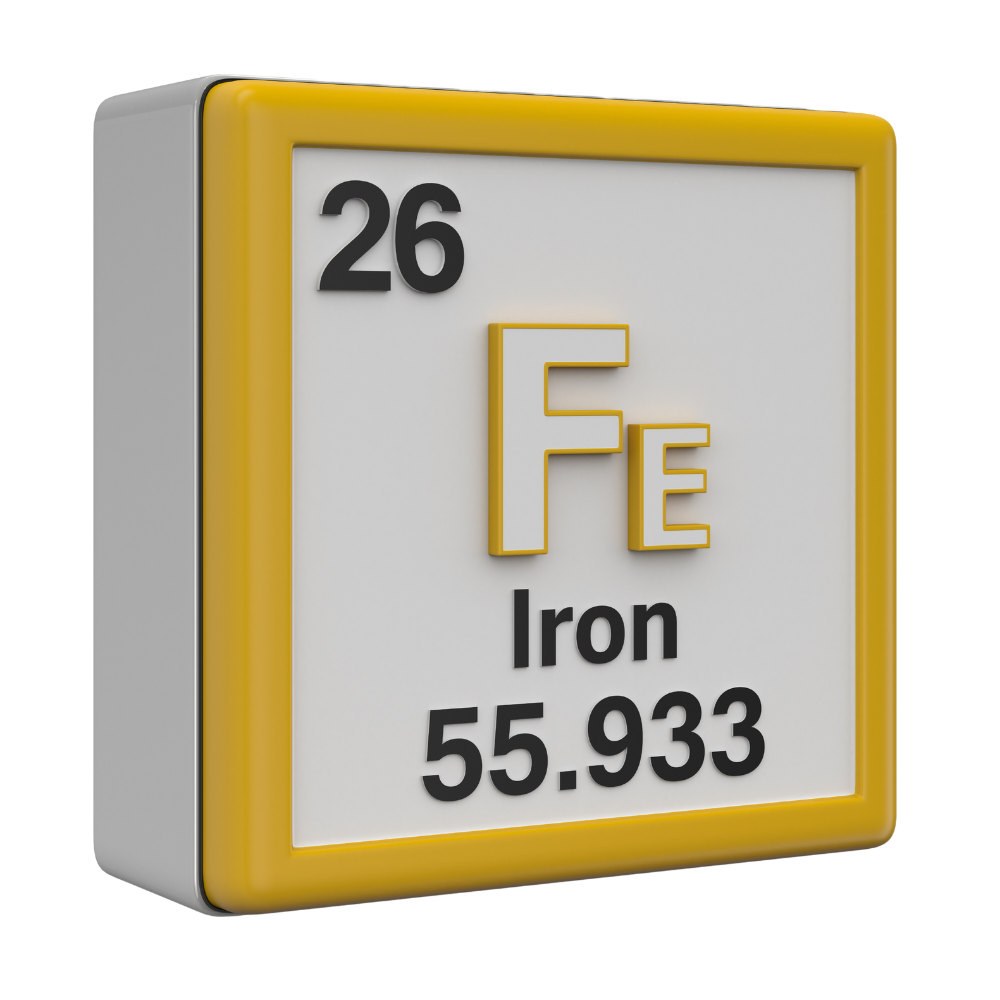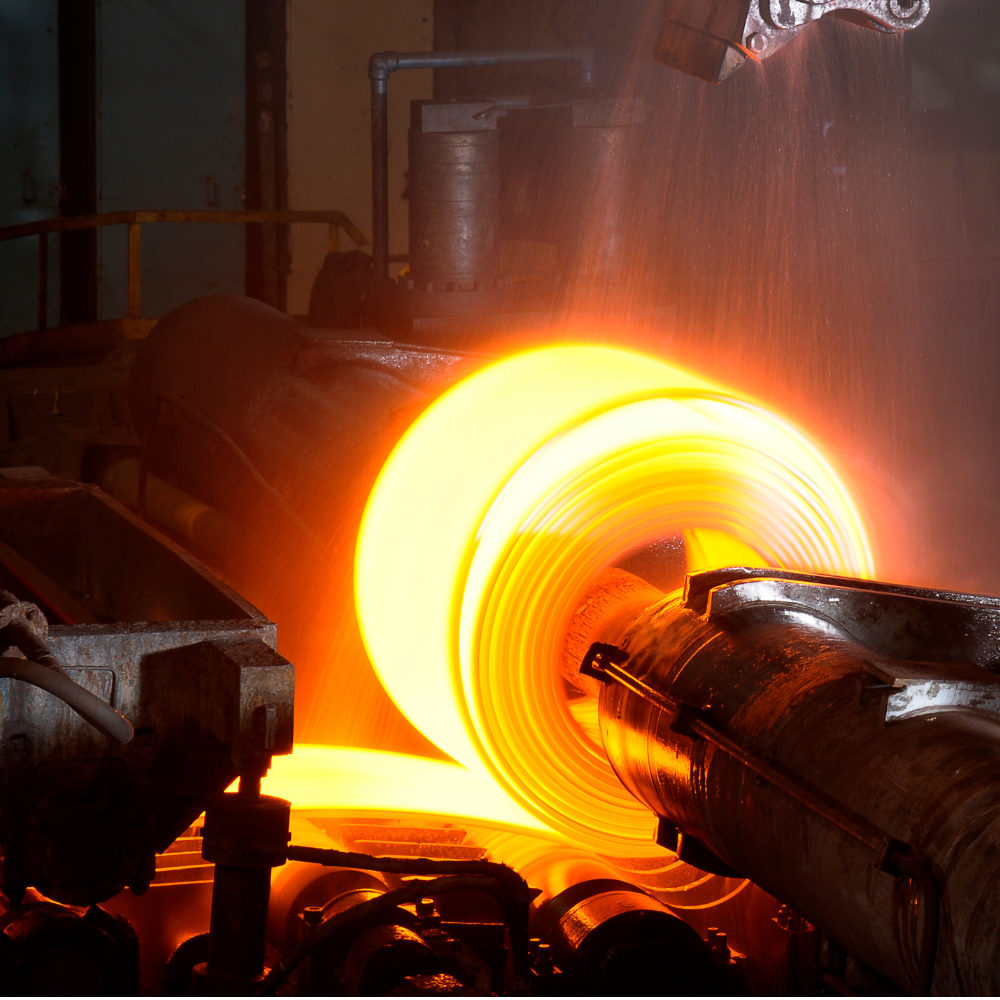Everything You Need to Know About Recycling Iron & Steel

Iron and steel, two fundamental building blocks of modern society, permeate every facet of our daily lives.
From the skyscrapers that dominate city skylines to the utensils we use in our homes, their significance is undeniable. Serving as a bedrock for both residential needs, such as stainless-steel appliances and cast iron pots, and commercial applications in construction and manufacturing, the roles of iron and steel are as diverse as they are crucial. Delve into the journey of these metals, from their rich histories to their current uses, and discover the importance of recycling and the future trends that could reshape the industry.
What is Iron?
Iron, known by the symbol Fe, has played a big role in human history. It's one of the most common elements on Earth and has been used for thousands of years. It's witnessed the rise and fall of civilizations, the creation of empires, and the progress of time.
Iron is special because it is especially malleable and can be bent and shaped easily. This makes it an important part of many things we use every day.
In the Earth's crust, iron is usually found as iron oxides, which are formed by natural processes over a very long time. Pure iron is quite soft, but it becomes much stronger when mixed with other elements to make alloys.
Iron has been a key player in the development of metallurgy, the creation of steel, and the construction of buildings that define our modern world. Its strength, flexibility, and ability to adapt have made it crucial for our industrial and technological advancements, shaping the essence of our ever-evolving civilization.


What is Steel?
In contrast to pure iron, steel is a unique material formed by combining iron with a relatively small amount of carbon. This alloy typically contains between 0.2% to 2.1% carbon by weight, and it's remarkable how such a seemingly slight variation in composition can yield a wide array of distinct properties in steel.
By tinkering with the carbon content and introducing other alloying elements such as chromium, nickel, or manganese, steel can be customized to display an impressive spectrum of mechanical characteristics. For instance, by increasing the carbon content, steel can be rendered exceptionally hard, making it suitable for applications where durability and resistance to wear are paramount. Conversely, by altering the alloy composition, it can achieve remarkable flexibility, making it ideal for applications that require malleability and strength.
This remarkable adaptability places steel at the forefront of versatile materials, finding its indispensable role across an extensive range of industries and applications. Whether it's used in construction, automotive manufacturing, aerospace, or even medical devices, the ability to fine-tune steel's properties to meet specific needs has solidified its status as a cornerstone material in the modern world. It's the material that bridges the gap between rigid strength and graceful flexibility, making it an essential element in countless everyday objects and industries.
The History of Iron

Iron's history begins with its use as a naturally occurring metal by ancient civilizations. The Hittites in Anatolia (modern-day Turkey) are often credited with the earliest known use of iron, around 2000 BCE. They created small iron objects like ornaments and pottery.
The Iron Age
By 1200 BC, the Bronze Era was coming to an end for several reasons: Iron was advantageous over bronze due to its abundance, affordability, and versatility. Iron tools and weapons were more durable and readily available, which transformed agriculture, construction, and warfare. This transition led to a profound shift in technology and culture, influencing the rise and fall of civilizations.
In particular, the rise of the Roman Empire saw the proliferation of iron usage in various aspects of daily life and infrastructure, from the famed Roman swords to the nails used in construction. This period marked a notable advancement in ironworking techniques, with the Romans pioneering methods to produce a purer form of iron, which paved the way for the development of steel centuries later.
During the Middle Ages, particularly in Europe, the art of ironworking took great strides. Blacksmiths harnessed the power of water-driven hammers, significantly improving the quality and quantity of iron production. The introduction of blast furnaces further enhanced the process.
The History of Steel: The Industrial Revolution
Steel, a versatile and durable alloy, has been pivotal in the evolution of human civilization. Let's embark on a journey through time to discover the remarkable story of steel. The 18th and 19th centuries brought the Industrial Revolution, a transformative era for steel production. Innovations like the Bessemer process, a method that allowed for the mass production of steel by blowing air through molten iron to burn off impurities, and open-hearth process revolutionized steelmaking, making it more affordable and accessible than ever before. This period witnessed the construction of railways, bridges, and machinery, all reliant on the strength and versatility of steel.
Modern Steelmaking:
In the 20th century, advancements in metallurgy and technology continued to push the boundaries of steel production. The development of specialty alloys and the refinement of steel's properties expanded its applications in diverse industries, from construction and automotive to aerospace and manufacturing.
Contemporary Steel:
Today, steel remains a cornerstone of modern life. It plays a pivotal role in our infrastructure, transportation, and daily lives. Steel's adaptability, strength, and recyclability make it an indispensable material, serving as the backbone of countless structures and objects that define the 21st century.

The Chemical Compositions of Iron & Steel
The diversity in the properties and applications of iron and steel largely stems from their compositional differences and the various types that can be produced. These metals can be tailored with precision, ensuring they meet the specific demands of an array of applications.

Iron (Fe)
Basic Element: Derived primarily from iron ores like hematite and magnetite.
Characteristics: Soft, ductile, malleable, and has a high susceptibility to oxidation (rusting).

Stainless Steel
Composition: Iron, carbon, and at least 10.5% chromium content.
Characteristics: Highly resistant to corrosion and staining. Commonly used in cutlery, surgical instruments, and appliances.

Alloy Steel
Composition: Iron, carbon, and other elements such as chromium, nickel, or manganese.
Characteristics: Enhanced strength, hardness, or chemical resistance based on the alloying elements.

Tool Steel
Composition: Various combinations of iron, carbon, and alloying elements.
Characteristics: Known for hardness and resistance to abrasion. Used for cutting or shaping materials.

Carbon Steel
Composition: Primarily iron with up to 2.1% carbon
Characteristics: Carbon steel is a highly versatile and affordable material known for its strength, malleability, and weldability. With a carbon content ranging from 0.05% to 2.0%, it offers a balance of hardness and ductility, making it suitable for various applications. This steel type is easily shaped and processed, allowing for cost-effective manufacturing.

Low Carbon Steel
Composition: Contains up to 0.3% carbon.
Characteristics: Low carbon steel, also known as mild steel, is a common choice for general manufacturing, fabrication, and machining processes. It can be easily shaped, cut, and welded to create various products and structures. Nuts, bolts, screws, and other fasteners are often made from low carbon steel as well as metal furniture and appliances.

Medium Carbon Steel
Composition:Contains 0.3-0.6% carbon.
Characteristics: Medium carbon steel is used in crankshafts, axles, and gears due to its strength and toughness. Blacksmiths often prefer medium carbon steel for creating tools, blades, and decorative ironwork, due to its balance between hardness and workability.

High Carbon Steel
Composition: Contains 0.6-2.1% carbon.
Characteristics: High carbon steel is used in cutting tools such as knives, chisels, and saw blades. It is also used in concrete constructions as rebar, to create automotive suspensions and railway tracks.
Common Applications of Iron & Steel
Throughout human history, the discovery and subsequent applications of iron and steel have played a pivotal role in societal advancement. Their unique combination of strength, malleability, and adaptability has allowed them to permeate virtually every facet of human existence. From ancient forges shaping tools of survival to modern industrial applications that bolster economies, the roles of iron and steel are vast and multifaceted.
What Are The Benefits of Recycling Iron & Steel
The significance of recycling iron and steel extends beyond surface-level environmental benefits; it intertwines with intricate industrial processes, energy consumption metrics, and the broader global economy. Recycling these metals is a culmination of technical advancements and a commitment to sustainable progress.
From an environmental and metallurgical standpoint, steel recycling leads to a considerable reduction in raw material usage, primarily iron ore and coal. This conservation is crucial given the energy-intensive nature of iron ore extraction and beneficiation processes. Using scrap steel in Electric Arc Furnaces (EAF) or as a supplement in Basic Oxygen Furnaces (BOF) drastically reduces the energy expenditure compared to processing raw iron ore in blast furnaces. This transition to recycling not only diminishes greenhouse gas emissions but also decreases other pollutants like particulate matter, sulfur dioxide, and nitrogen oxides.
The reduced energy consumption in steel recycling is further emphasized when analyzing the thermodynamics of metal processing. Recycled steel, already in a refined state, requires fewer steps to re-melt and reform compared to converting iron ore, which undergoes reduction, melting, and refinement. This streamlined process leads to savings of up to 60-74% in energy when recycling steel.
Economically, the technical efficiencies of steel recycling translate into tangible benefits. The cost reductions associated with decreased energy consumption, along with the stability of sourcing local scrap over imported raw materials, make it an attractive proposition for industries. The recycling process, with its various stages from collection to processing and distribution, has also proven to be a significant contributor to job markets. Moreover, the predictability of supply from recycled sources can mitigate the risks associated with fluctuating raw material prices or geopolitical disruptions. Furthermore, steel's inherent properties, such as its magnetic nature, make it one of the most recyclable materials on the planet. This technical advantage ensures that steel retains its quality regardless of the number of recycling iterations, making it a perpetually reusable resource.
Mining & Production of Iron & Steel
The journey of iron and steel, from the earth's crust to the structures and machines of our world, showcases human innovation and the adaptability of these metals. It all begins with mining, extracting iron ores like hematite and magnetite from open-pit and underground mines. After mining, beneficiation processes enhance iron content and reduce impurities. Techniques like crushing and magnetic separation are used. Next comes smelting, reducing iron ores in blast furnaces with coke and limestone. This produces pig iron, high in carbon and brittle, which undergoes steelmaking. The Basic Oxygen Furnace reduces carbon content, while the Electric Arc Furnace melts scrap steel. The molten steel is then cast into shapes and processed in rolling mills to create final steel products. Steel's versatility allows for alloying elements like chromium and nickel to be added, creating specialized grades for various uses.
Economic Benefits of Recycling Iron & Steel
The iron and steel industry wields significant influence on the global economy and environment, serving as vital components of modern infrastructure with extensive economic impact. These metals play crucial roles in job markets, transportation, and construction, contributing substantially to the GDPs of numerous countries. However, the costs of iron and steel are subject to fluctuations influenced by factors like raw material availability, geopolitical scenarios, and global demand, affecting everything from large construction projects to everyday consumer goods.
Recycling Iron & Steel is a Win-Win for the Environment
Recycling iron and steel is environmentally beneficial because it conserves natural resources, reduces energy consumption, and minimizes greenhouse gas emissions. This process lessens the demand for new raw materials, such as iron ore, leading to the preservation of ecosystems. By diverting scrap metal from landfills, recycling reduces waste and helps manage landfill space. It also conserves water resources and aligns with the principles of a circular economy, promoting sustainability and economic synergy.
By recycling Iron & Steel, we commit to a sustainable and eco-friendly future.

Iron & Steel's Global Presence
The iron and steel sector holds a significant worldwide influence, playing a vital role in the economic development and infrastructure of nations across the globe. Found in diverse applications from construction to manufacturing, iron and steel are essential materials underpinning the framework of modern societies. Major steel-producing countries, including China, India, & the United States, contribute significantly to the industry's global footprint.
The dynamics of international trade, tariffs, and geopolitical considerations are intrinsically tied to the iron and steel market, shaping the industry's presence on a global scale.

Future Trends in Iron & Steel Use
Poised for an exciting future marked by transformative trends, the iron and steel industry is strong as ever. Advancements in sustainable production methods, including breakthroughs like hydrogen-based steelmaking, hold the potential to revolutionize the sector by reducing carbon emissions and aligning with global climate goals. Innovations in recycling technology, such as advanced sorting mechanisms and AI-driven quality checks, promise to enhance the efficiency and purity of recycled iron and steel, ensuring its quality matches or surpasses traditionally produced steel. As industries worldwide prioritize sustainable practices, the demand for recycled steel is expected to surge, especially in the automotive and construction sectors.
Common Questions About Recycling Iron & Steel
Iron and steel both predominantly consist of the element iron. Steel is an alloy made primarily of iron with the addition of carbon and sometimes other elements. This intrinsic connection means they share many physical properties, though steel's added components often enhance its strength and durability.
Iron is a natural element, while steel is an alloy primarily composed of iron and carbon. The addition of carbon, and sometimes other elements like chromium or nickel, gives steel its unique properties.
Recycling iron and steel is environmentally beneficial. It conserves finite natural resources, reduces the energy-intensive process of mining, and minimizes environmental degradation. Moreover, recycling these metals consumes less energy than producing them from raw ore, leading to fewer greenhouse gas emissions.
When iron is recycled, it is collected, sorted, and then melted down in furnaces. Impurities are removed, and the purified iron is then cast into new products. This recycling process preserves the inherent properties of iron, ensuring that its quality remains consistent.
Globally, a significant percentage of iron and steel products are recycled. For steel around 85% of end-of-life products are recycled, making it one of the most recycled materials in the world.
While most steel types are recyclable, certain steel products coated with other materials or contaminated with hazardous elements can pose challenges. Examples include steel coated with heavy paints, lead, or other non-removable coatings.
Old baking trays, if made of recyclable metals like aluminum or steel, can typically be recycled. Metal jar lids, usually made of steel or aluminum, are also recyclable. However, it's crucial to consult local recycling guidelines as there might be size or contamination considerations.
Cold-rolled steel often displays strength up to 20% higher than its hot-rolled counterpart, making it particularly well-suited for high-stress applications. Additionally, components and items crafted from cold-rolled steel typically boast smooth, shiny surfaces devoid of rust and scale, contributing to superior aesthetic and functional qualities.
Recycling the curls of steel produced during metalworking processes, such as machining or turning, are often referred to as "metal shavings" or "metal chips." These terms describe the small, curled pieces of metal that result from the cutting or shaping of a larger metal workpiece. What might look like waste at first glance, can be recycled for cash to help offset overhead costs for manufacturing businesses. If you have a large quantity to recycle, contact C&D Scrap Metal today to schedule a free on-site assessment so they can provide a custom option to support your metal recycling needs.
C&D Scrap Metal is the premier Houston areas scrap yard for selling iron and steel. C&D pays top prices for metals of many types, including iron and steel. Steel and iron pricing changes daily based on market supply and demand, so to get the most current pricing, you can call or visit any of the C&D Scrap Metal locations.
There are three convenient locations to recycling your iron and steel for cash. C&D Scrap Metal at 6775 Bingle Rd, Houston, TX 77092, the southwest location at 10400 SW Plaza Dr, Houston, TX 77074, and the Fort Bend / Sugar Land location at 15222 Mc Kaskle Rd, Sugar Land, TX 77498.

